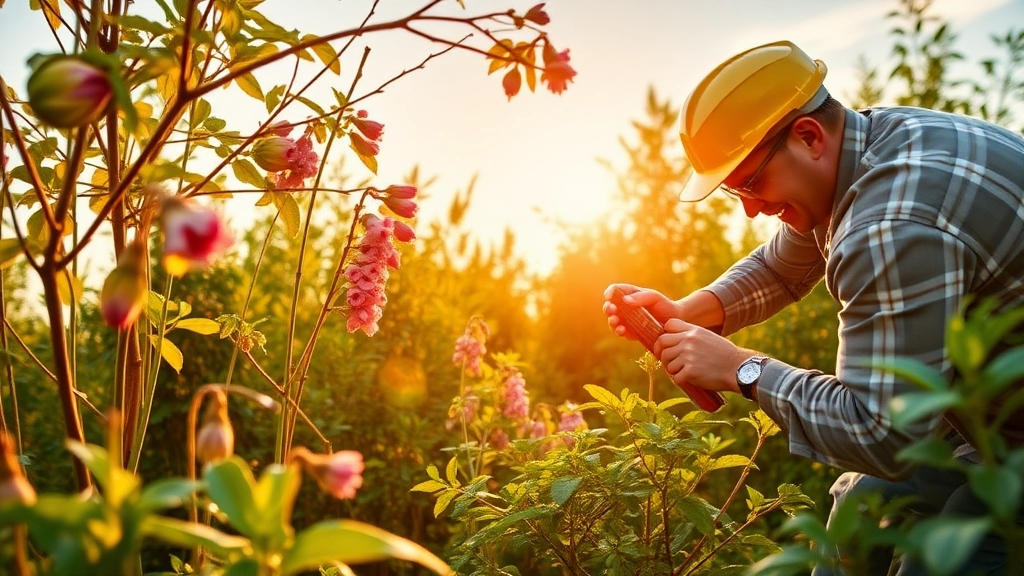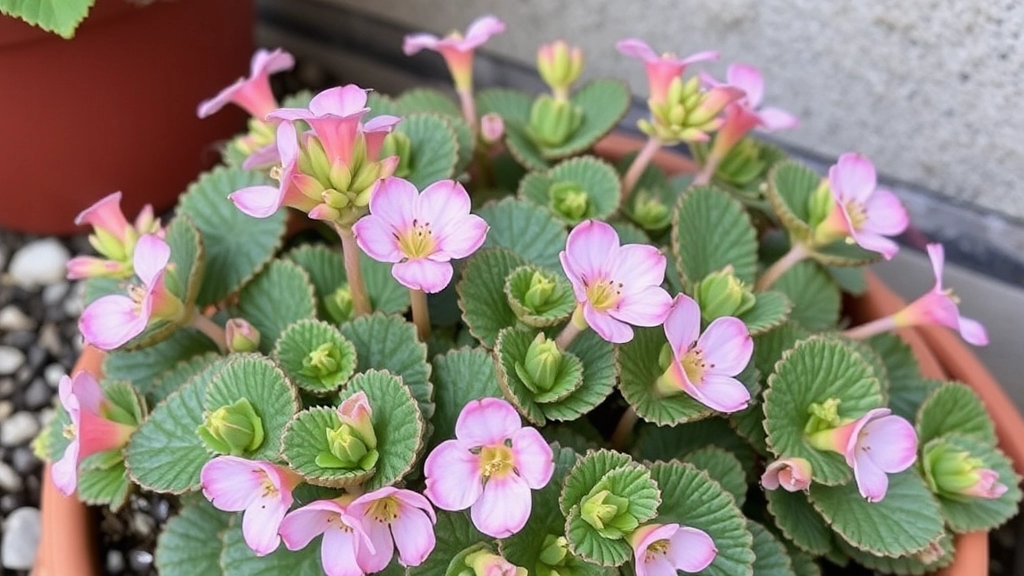Kalanchoe Mother of Thousands
The Kalanchoe Mother of Thousands is a fascinating succulent known for its unique ability to produce plantlets along the edges of its leaves. As an indoor gardener, I’ve found this plant to be both intriguing and rewarding to grow. If you’re looking to add a touch of nature’s wonder to your home, understanding the care and propagation of this plant is essential.
Care and Propagation
From providing the right light and temperature to mastering watering techniques, there are several key factors to ensure your Mother of Thousands thrives. Additionally, knowing how to manage its growth and prevent invasiveness can save you from potential headaches.
Why Grow Kalanchoe Mother of Thousands?
- Unique Plantlets: Produces small plantlets along leaf edges.
- Indoor Gardening: Perfect for indoor environments.
- Low Maintenance: Requires minimal care once established.
Whether you’re a seasoned plant enthusiast or a curious beginner, this guide will help you nurture your Kalanchoe Mother of Thousands effectively.
Unique Features of Kalanchoe Mother of Thousands
When considering houseplants, the Kalanchoe Mother of Thousands stands out for its remarkable characteristics.
This succulent is known for its unique ability to produce numerous plantlets along the edges of its leaves, giving it the nickname “Mother of Thousands.”
Key Features:
- Leaf Structure: Its thick, fleshy leaves are typically green with a hint of blue, creating an eye-catching display.
- Growth Habit: The plant can grow up to 60 cm tall, forming a bushy appearance that adds texture to any space.
- Flowering: In optimal conditions, it produces clusters of tubular flowers that can range from pink to yellow, adding a splash of colour.
- Adaptability: This plant thrives in various environments, making it suitable for both indoor and outdoor settings.
- Low Maintenance: Kalanchoe Mother of Thousands is drought-tolerant, requiring minimal care, which is perfect for busy individuals.
For more detailed care instructions, check out our comprehensive guide on growing and caring for Kalanchoe Mother of Thousands. Additionally, if you’re interested in propagation techniques, our propagation guide for Kalanchoe Mother of Thousands offers step-by-step instructions.
Light and Temperature Requirements

So, you’ve got your Kalanchoe Mother of Thousands, and now you’re wondering about its light and temperature needs.
Light Requirements
This little beauty loves the sun, but it’s a bit picky about how much it gets. Here’s the lowdown:
- Bright, Indirect Light: Ideally, it thrives in bright, indirect sunlight. Think of a cozy spot near a window where it can soak up the rays without getting scorched.
- Direct Sunlight: A few hours of direct sunlight won’t hurt, but too much can lead to crispy leaves. If you notice any browning, it might be time to move it back a bit.
- Low Light: It can survive in low light, but don’t expect it to flourish. It’ll become leggy and less vibrant.
Temperature Needs
When it comes to temperature, Kalanchoe Mother of Thousands is pretty chill. Here’s what you need to know:
- Ideal Range: Aim for a temperature range of 20°C to 25°C (68°F to 77°F). This is its happy place.
- Avoid Cold Drafts: It doesn’t like the cold, so keep it away from chilly drafts or sudden temperature changes. If things dip below 10°C (50°F), it’s time to bring it indoors.
- Humidity: This plant isn’t too fussy about humidity, but it prefers drier conditions.
When it comes to caring for your Kalanchoe Mother of Thousands, one of the most pressing concerns is how to get the watering just right. Overwatering can lead to root rot, while underwatering can cause the plant to wilt. So, how do you strike the perfect balance?
Watering Guidelines:
– **Frequency:** Water your Mother of Thousands every 2-3 weeks during the growing season (spring and summer). In the winter, reduce this to once a month.
– **Soil Check:** Always check the soil moisture before watering. Stick your finger about an inch into the soil; if it feels dry, it’s time to water.
– **Watering Method:** When watering, do so thoroughly. Allow water to flow out of the drainage holes at the bottom of the pot. This ensures that the roots receive adequate moisture.
– **Avoid Standing Water:** Ensure that excess water does not collect in the saucer beneath the pot. This can lead to root rot.
– **Signs of Overwatering:** Yellowing leaves or a mushy stem are clear signs that you may be giving your plant too much water.
– **Signs of Underwatering:** If the leaves begin to shrivel or curl, it’s time to increase your watering frequency.
By following these straightforward watering tips, you can help your Kalanchoe Mother of Thousands thrive in your home. For more detailed information on caring for this unique plant, check out our guide on [Mother of Thousands Care](https://planthq.org/mother-of-thousands-care-light-water-propagation-safety/). Additionally, if you’re interested in propagation techniques, our [Step-by-Step Guide to Kalanchoe Mother of Thousands Propagation](https://planthq.org/stepbystep-guide-kalanchoe-mother-of-thousands-propagation/) might be useful.
Best Soil and Potting Practices for Kalanchoe Mother of Thousands

When considering the best soil and potting practices for your Kalanchoe Mother of Thousands, you might wonder about the ideal conditions to ensure healthy growth.
Soil Type
- Well-Draining Soil: The key to a thriving Kalanchoe is well-draining soil. A cactus or succulent mix works wonders.
- pH Level: Aim for a slightly acidic to neutral pH, ideally between 6.0 and 7.0, to support nutrient absorption.
Pot Selection
- Drainage Holes: Always choose pots with drainage holes. This prevents water from pooling, which can lead to root rot.
- Size Matters: A pot that is too large can retain excess moisture. Opt for a pot that allows for a bit of room for growth without being overly spacious.
Repotting Tips
- Frequency: Repot every 1-2 years or when you notice roots emerging from the drainage holes.
- Timing: Spring is the best time for repotting, as the plant is entering its active growth phase.
Potting Process
- Remove the Plant: Gently take the Kalanchoe out of its current pot.
- Inspect the Roots: Check for any damaged or rotten roots and trim them.
- Add Fresh Soil: Place a layer of fresh soil at the bottom of the new pot.
- Position the Plant: Set the Kalanchoe in the centre and fill around it with more soil.
- Water Lightly: After potting, give it a light watering to settle the soil without over-saturating.
Are you wondering how to expand your Kalanchoe Mother of Thousands collection?
Propagation is an exciting and rewarding process that allows you to grow new plants from the existing ones.
## Propagation Methods: Plantlets and Cuttings
### Plantlets
One of the most fascinating features of the Kalanchoe Mother of Thousands is its ability to produce numerous plantlets along the edges of its leaves.
These tiny plants are ready to take root and can be easily removed for propagation. Here’s how to do it:
– **Select Healthy Leaves:** Choose mature leaves that have a good number of plantlets.
– **Gently Remove:** Carefully detach the leaf from the main plant.
– **Allow to Callous:** Let the leaf sit for a day or two in a dry place to form a callous over the cut area. This helps prevent rot.
– **Plant in Soil:** Place the leaf on top of well-draining soil, ensuring the plantlets are touching the soil.
– **Water Sparingly:** Mist the soil lightly to encourage rooting without overwatering.
### Cuttings
If you prefer, you can also propagate Kalanchoe through stem cuttings. This method can be particularly effective for creating bushier plants. Here’s a straightforward guide:
– **Choose a Healthy Stem:** Look for a healthy, non-flowering stem.
– **Cut the Stem:** Using clean, sharp scissors, cut a section of the stem about 4-6 inches long.
– **Remove Lower Leaves:** Strip off the lower leaves to expose the nodes.
– **Let it Dry:** Allow the cutting to dry for a few hours or overnight to form a callous.
– **Plant in Soil:** Insert the cutting into well-draining soil, burying the nodes.
– **Water Gently:** Water lightly and place the pot in a warm, bright location.
Both methods are effective, and you can choose based on your preference and the resources available. For more detailed steps, you can check out this [Kalanchoe Mother of Thousands Propagation Guide](https://planthq.org/kalanchoe-mother-of-thousands-propagation-guide/). Additionally, if you want to explore other propagation techniques, consider reading about [How to Propagate Kalanchoe Leaves](https://planthq.org/how-to-propagate-kalanchoe-leaves-a-stepbystep-guide/).
Managing Growth and Preventing Invasiveness

So, you’ve got your Kalanchoe Mother of Thousands thriving, but now you’re wondering how to keep it in check, right?
These little beauties can spread like wildfire if left unchecked, so let’s dive into some practical tips to manage their growth and avoid any invasiveness issues.
1. Regular Pruning
- Snip back those long stems and unwanted offsets.
- This not only keeps the plant looking tidy but also encourages bushier growth.
- Use clean, sharp scissors to avoid any disease transfer.
2. Control Plantlets
- Mother of Thousands produces tiny plantlets that can easily take root.
- If you notice them popping up everywhere, gently remove them.
- You can pot them up or share with friends!
3. Container Gardening
- Consider keeping your plant in a pot rather than in the ground.
- This limits its spread and makes it easier to manage.
- Choose a pot with drainage holes to prevent waterlogging.
4. Monitor Growth
- Keep an eye on how fast it’s growing.
- If it starts to take over, it might be time to give it a bigger pot or trim it back.
- Regular checks will help you stay ahead of any invasiveness.
5. Mind the Location
- Place your Mother of Thousands in a spot where it has room to breathe but isn’t too close to other plants.
- This way, it won’t compete for space or resources.
Common Issues: Pests, Diseases, and Toxicity
When caring for Kalanchoe Mother of Thousands, it’s essential to be aware of potential challenges that can arise. Understanding these issues can help you maintain a healthy plant.
Pests to Watch For:
- Mealybugs: These small, white insects can cluster on leaves and stems, sucking sap and weakening the plant.
- Spider Mites: Tiny and often invisible, these pests thrive in dry conditions, causing stippling on leaves.
- Aphids: These green or black insects can also sap your plant’s strength, leading to stunted growth.
Diseases to Consider:
- Root Rot: Overwatering is a common culprit for root rot. Ensure your plant has well-draining soil and pots with drainage holes.
- Powdery Mildew: This fungal disease appears as a white powdery substance on leaves, often due to high humidity. Good air circulation can help prevent it.
Toxicity Concerns:
Kalanchoe Mother of Thousands is mildly toxic to pets and humans if ingested. Symptoms may include vomiting or diarrhoea. Always keep your plant out of reach of curious pets and children.
Prevention Tips:
- Regularly inspect your plant for signs of pests or disease.
- Maintain proper watering practices to avoid root rot.
- Ensure adequate airflow around the plant to reduce humidity and prevent fungal infections.
For more detailed information on keeping your Kalanchoe healthy, check out our Optimal Care Guide for Kalanchoe Paddle Plant. If you’re interested in the health benefits, you might also find our article on the Health Benefits of Kalanchoe Pinnata Juice useful.
Ideal Indoor and Outdoor Growing Conditions for Kalanchoe Mother of Thousands
So, you’ve got your Kalanchoe Mother of Thousands and you’re wondering where it’ll thrive best, right?
Let’s break it down.
Indoor Conditions
When it comes to indoor growing, these plants are pretty chill but do have some preferences:
- Light: They love bright, indirect sunlight. A south or west-facing window is perfect.
- Temperature: Keep it cozy between 18°C to 24°C. They can handle a bit cooler, but avoid anything below 10°C.
- Humidity: They aren’t fussy about humidity, but if your home is super dry, a little misting won’t hurt.
Imagine placing your plant on a sunny windowsill, basking in that warm glowâit’s a win-win!
Outdoor Conditions
Thinking of taking your Kalanchoe outside? Here’s what you need to know:
- Light: Full sun is the way to go. Aim for at least 6 hours of direct sunlight.
- Temperature: They thrive in warmer climates. Ideally, keep them above 15°C.
- Soil: Well-draining soil is a must. A gritty mix works wonders.
Picture your plant soaking up the sun in your garden, looking vibrant and full of life.
Tips for Both Worlds
- Watering: Adjust your watering based on the season. Less in winter, more in summer.
- Wind Protection: If outdoors, shield them from harsh winds. They’re delicate little beauties!
For more detailed care tips, you might find our guide on growing Kalanchoe Tomentosa helpful. Additionally, if you’re dealing with any leaf issues, check out our article on why Kalanchoe leaves might be dying and how to fix it.
FAQs About Kalanchoe Mother of Thousands
What are the light requirements for Kalanchoe Mother of Thousands?
Kalanchoe Mother of Thousands thrives in bright, indirect sunlight. It can tolerate a few hours of direct sunlight but too much can cause leaf browning. It can survive in low light, but it will become leggy and less vibrant.
What temperature range is ideal for Kalanchoe Mother of Thousands?
The ideal temperature range is between 20°C to 25°C (68°F to 77°F). It should be kept away from cold drafts and sudden temperature changes. If temperatures drop below 10°C (50°F), it should be brought indoors.
What type of soil is best for Kalanchoe Mother of Thousands?
Kalanchoe Mother of Thousands prefers well-draining soil. A cactus or succulent mix is ideal. The soil pH should be slightly acidic to neutral, ideally between 6.0 and 7.0.
How often should I repot my Kalanchoe Mother of Thousands?
Repotting should be done every 1-2 years or when you notice roots emerging from the drainage holes. Spring is the best time for repotting, as the plant is entering its active growth phase.
How can I manage the growth of Kalanchoe Mother of Thousands?
To manage growth, regular pruning is essential. Snip back long stems and unwanted offsets to keep the plant tidy and encourage bushier growth. Also, control the plantlets by gently removing them if they start popping up everywhere.
Is Kalanchoe Mother of Thousands invasive?
Kalanchoe Mother of Thousands can be invasive if left unchecked. To prevent invasiveness, consider container gardening, regularly monitor growth, and place the plant in a spot where it has room to breathe but isn’t too close to other plants.
What are the best potting practices for Kalanchoe Mother of Thousands?
Choose pots with drainage holes to prevent water pooling and root rot. Avoid using overly large pots to prevent excess moisture retention. When repotting, inspect the roots, trim any damaged ones, and use fresh soil.
How do I control the spread of plantlets from Kalanchoe Mother of Thousands?
Mother of Thousands produces tiny plantlets that can easily take root. If you notice them spreading, gently remove them. You can pot them up or share them with friends to control their spread.
References
-
How to Grow Kalanchoe Mother of Thousands
-
Mother of Thousands Plant Care
-
Kalanchoe Mother of Thousands Guide
